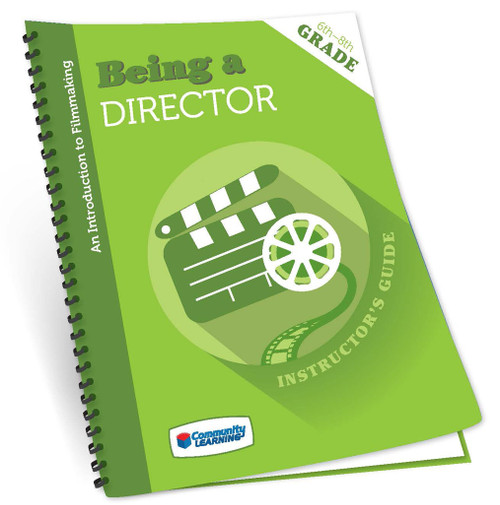
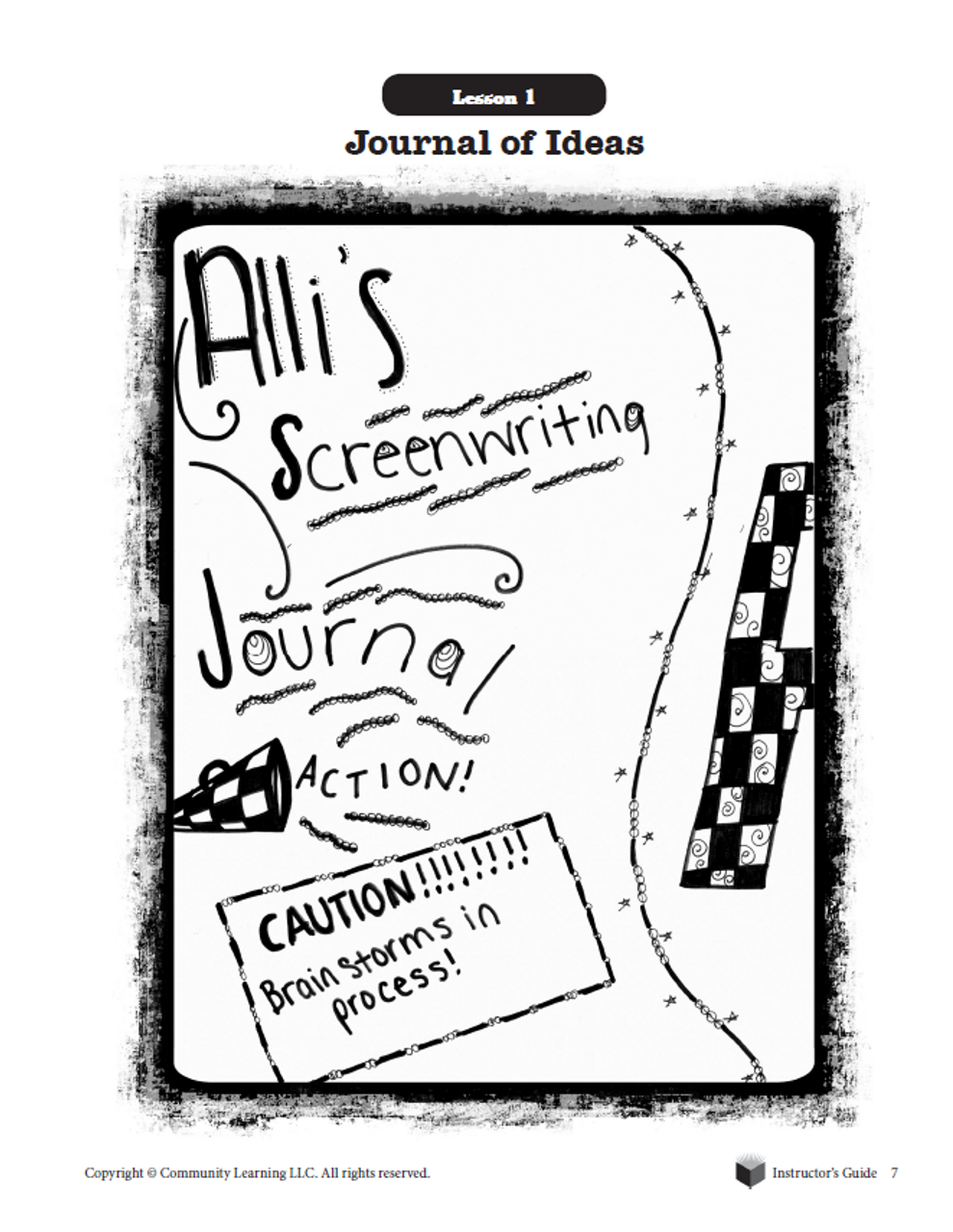






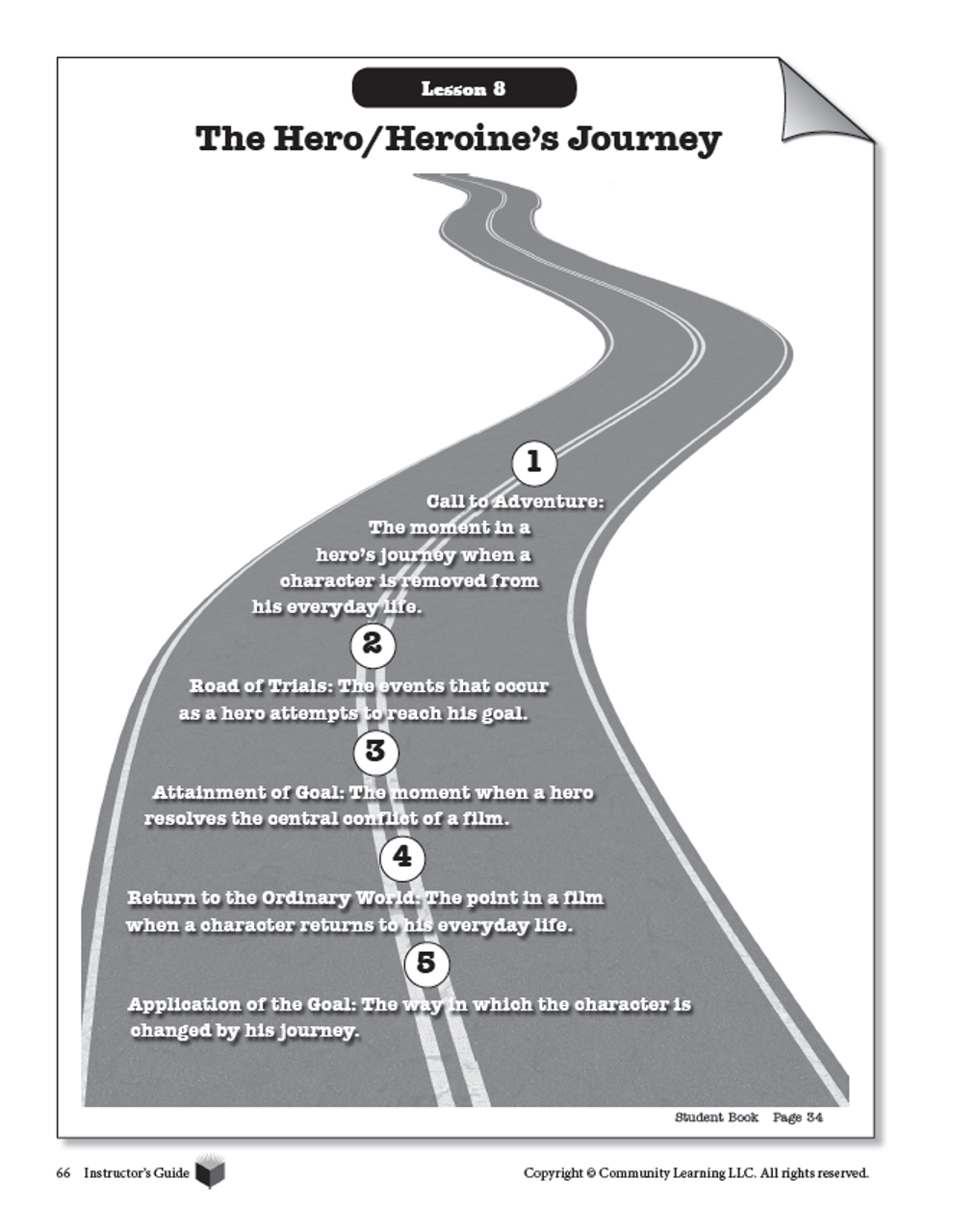

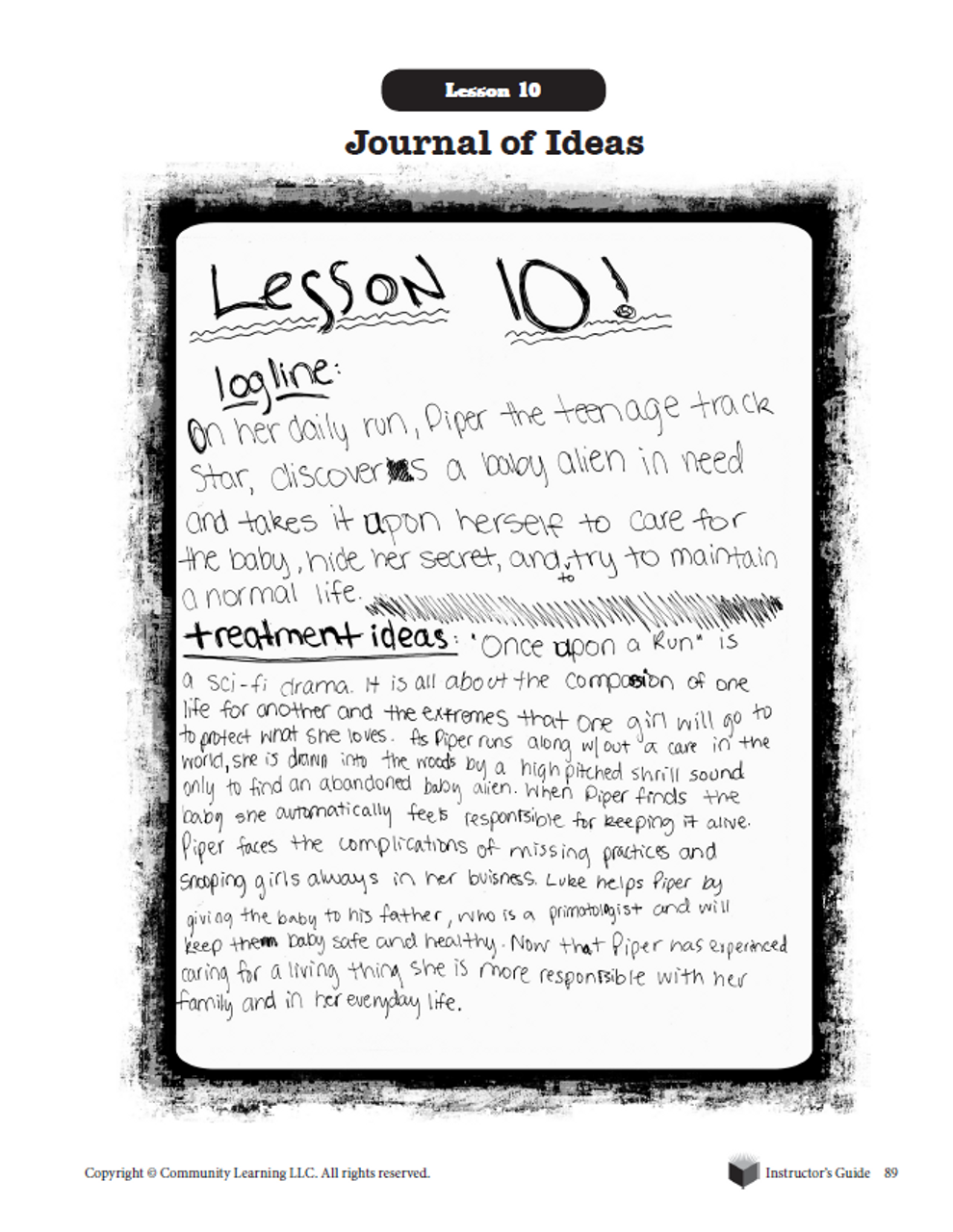


Being a Screenwriter Part 1: Generating Ideas for a Screenplay Instructor's Guide & Resources
Community Learning
- SKU:
- BAS1900-IG
- Shipping:
- Free Shipping
- Grades:
- 6-8
- Group Size:
- 2-4
- In Stock:
- 36
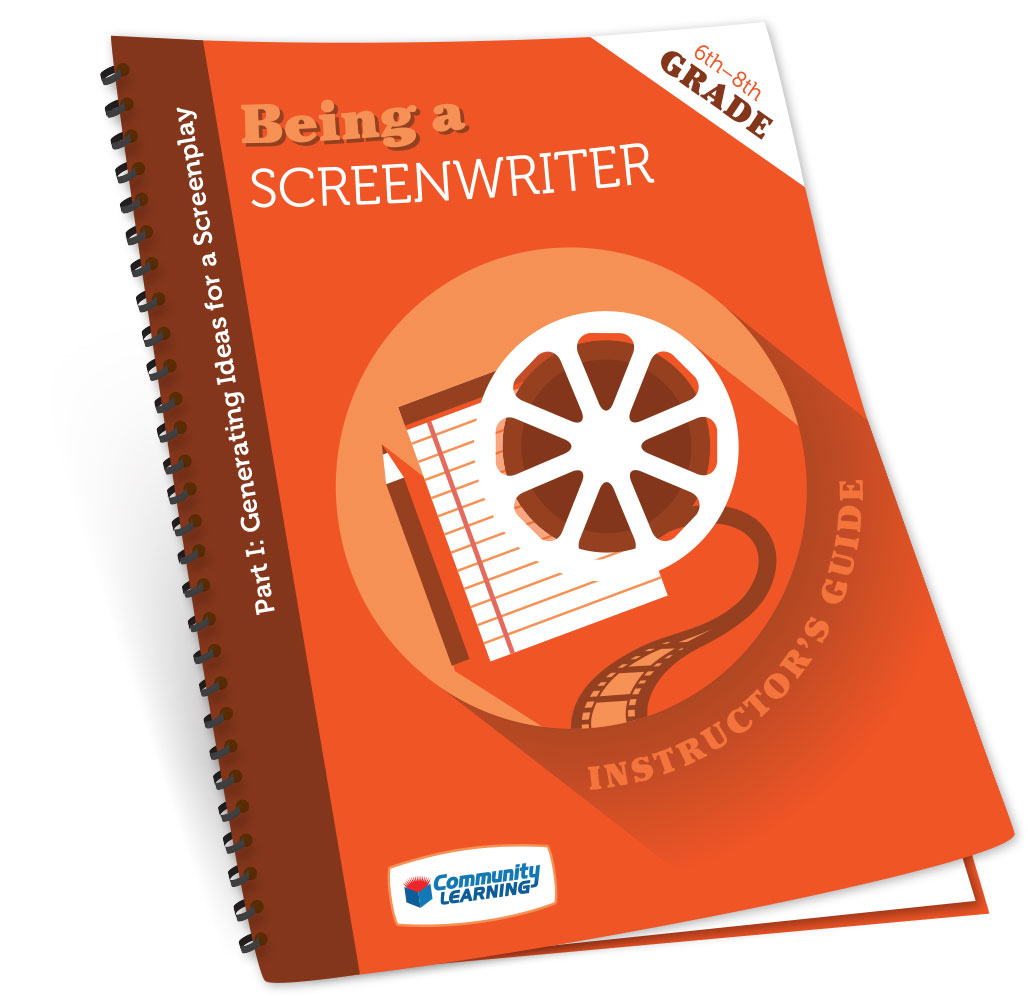 This project-based screenwriting curriculum is designed to enrich the writing and language skills of students in grades 6-8. This fun, engaging 10-unit course (with each lesson lasting about an hour) program gets right down to the business of developing scripts and encourages learners to brainstorm their experiences for a story idea. Students pitch their treatment to the class before proceeding to a final script! Students will then translate their ideas into a authentic script through in part 2 of this fun curriculum. They'll learn how to mesh characters, dialogue and scenes into an interesting and entertaining short film!
This project-based screenwriting curriculum is designed to enrich the writing and language skills of students in grades 6-8. This fun, engaging 10-unit course (with each lesson lasting about an hour) program gets right down to the business of developing scripts and encourages learners to brainstorm their experiences for a story idea. Students pitch their treatment to the class before proceeding to a final script! Students will then translate their ideas into a authentic script through in part 2 of this fun curriculum. They'll learn how to mesh characters, dialogue and scenes into an interesting and entertaining short film!
Exciting activities such as “The Psychiatrist’s Couch” and “Heroes and Heroines” provide hands-on, practical hints on how to put the pieces of storytelling together. These activities actually generate scripts and critical elements for a student’s initial outlines, and create springboards for further development. Along the way, instructors guide students through peer review and sharing sessions that underscore the realistic process of shaping their ideas into workable screenplay skeletons. Throughout the course, a suggested writer’s journal encourages each learner to stay on task and collect wild flights of fancy that can be exploited for movie ideas.
Student writing comes alive in instruction that emphasizes the “show, don’t tell” principles that underlie successful film stories. Storyboarding activities also promote the visualization of scene creation that propels simple scripts into moving images. Games and exercises are designed to get learners’ creative juices flowing.
Most important, the key literacy activities, such as summarizing, brainstorming, and analyzing—a part of virtually every writing exercise—reinforce the critical thinking and standards-based benchmarks identified by national standards for achievement in English Language Arts. It’s no surprise that students discover—through Being A Screenwriter—just how much fun writing can be!
In Part 1 of this series, Generating Ideas for a Screenplay, learners begin in familiar territory, exploring the concepts of genre and theme in movies they already know. Step-by-step, they master the tricks of the trade, compiling ideas, shaping dialogues, creating fascinating personae, and investigating how conflict drives a story into production territory.
Course Outline and Lesson Descriptions
Part 1 - Generating Ideas for a Screenplay
Lesson 1 - The Kinds of Movies We Love: An Introduction to Genre and Theme
Students dive right into the screenwriting process with this introduction to understanding genre, in which the difference between Dracula and Cinderella really counts!
Lesson 2 - How Movies Work: The Three-Act Structure
What if Dorothy (The Wizard of Oz) found herself surrendering to Darth Vader (Star Wars)? In this lesson, mixing up the elements of storytelling helps learners understand the classic structure of movies of all kinds!
Lesson 3 - The Story You Can Tell: Writing from the Heart
Generating ideas for screenplays often represents a struggle between the heart and the head. Learners capture the best of both in this set of activities that use memories and photographs to jumpstart the creative process.
Lesson 4 - The Brainstorm: Coming Up with an Idea
The rapid-fire delivery of writing “prompts” in this lesson is sure to stimulate a swarm of new ideas. Most importantly, learners get the idea that inspiration can be found most anywhere—and that can always lead to writing something new!
Lesson 5 - Bringing It All Together: Making Your Ideas Work
“Story Stars”—an inventive activity that helps student screenwriters zero in on plotlines and story details—is at the center of this exciting lesson. Tabloid headlines also make a guest appearance in this lesson.
Lesson 6 - Developing Characters: Who Will Your Story Be About?
Characters come alive in this intriguing and revealing exploration of character development. Students discover new dimensions to character on “The Psychiatrist’s Couch”.
Lesson 7 - Understanding Conflict: What Will Your Story Be About?
Will the learners in your classroom craft stories with war, intrigue, disaster, crime, or failed romance at the heart of their stories? A return to familiar films introduces students to the concepts of analyzing conflict and its relationship to plot.
Lesson 8 - The Hero/Heroine's Journey: Managing Conflict and Character
Even the hero’s journey starts with a single step. Learners set off on the road to story-building in this important lesson that ties character and conflict in fun ways that stretch the muscles of imagination.
Lesson 9 - Thinking Cinematically: Showing Rather than Telling
The fundamental tool of screenwriting, the storyboard, is at the center of this introduction to cinematic thinking. As learners linking a chain of visuals in order to tell their stories, the principle of “show, don’t tell” makes good sense and great fun.
Lesson 10 - The Pitch: Writing Your Logline and Treatment
Imagine a film: “Twenty young screenwriters compete to win a Hollywood contract for a movie about themselves…” Learners wrap up their creations for the Hollywood litmus test: the challenge of “loglines” and “treatments” is explored in this activity on the big studio pitch
Instructor's Guide Preview
Page through the preview below and simply click the three dots to view in full screen.
Components
Instructor’s Guide
Every step is taken to provide an easy-to-follow format and informative, fun-to-read instructions for each lesson. In addition to a brief listing of objectives, materials, and set-up procedures, useful icons point the instructor to a number of key elements:
Notes for the Instructor: Brief instructor notes introduce the subject matter and challenges presented in the particular lesson. They often contain real-life, age-appropriate examples from movies that most students have seen.
Notes for the Students: These notes “set the stage” for each lesson by presenting brief material to read, listen to, and discuss.
Vocabulary: New and relevant terms are defined here. Note, too, the comprehensive “Glossary” at the end of the Instructor’s Guide and Student Books.
Activity Description: Here, step-by-step procedures are provided for both the instructor’s demonstration and the students’ immersion in the activity.
Wrap-up: Discussion-provoking questions and summary-type activities are designed to revisit the day’s learning and help students take their inquiry further.
Clean-up: Clear instruction on preserving and storing materials is provided to ensure kit longevity and cost effectiveness.
Other Destinations: To extend lessons and deepen understanding across disciplinary and cultural divides, relevant links to multimedia, web resources, and fun at-home or extension activities are provided here.
Student Book on CD
Designed for students to record their writings class after class, the Student Books acquire a quality that keeps the young screenwriters engaged in their project over time. The books serve as companions to the Instructor’s Guide and contain activity worksheets, questions to spark the imagination, and are a tool for students to brainstorm their screenplay ideas.
Companion Resources
When you adopt Being A Screenwriter: Generating Ideas for a Screenplay, your instructors will have access to a number of companion resources. A Teacher Resource CD includes tutorials for each lesson overview, lesson extensions, and other great ideas for the classroom. Links to videos and other multimedia resources provide authentic lesson extensions. Immediate support, including resupply materials is always available from the experts at Community Learning.
Supplies Needed
Home Alone DVD
Being a Screenwriter 1 - Movie Clips
Training Tips
Quick Start Tips for Teachers
Preparing Staff to Teach “Being a Screenwriter”
Welcome to the staff training notes for Being a Screenwriter, a series of 10 hands-on lessons in creativity and literacy. This program is ideal for after-school programs, summer and vacation camps, scout troops, church youth groups and anywhere that young people gather.
The challenges in teaching Being a Screenwriter are unique, and the success of each lesson depends on teaching with clarity, listening attentively, being ready to help students understand new information, and encouraging productivity.
This course requires that students write in response to a series of activities. Although students’ ideas are produced in their activity books or journals, it’s critical not to make them think that their writing will be judged. We are not interested in spelling or grammatical correctness or the “right” answers in this course. Instead, we want students to feel empowered in their writing; we want their ideas to be uncensored.
Who can teach Being a Screenwriter?
Any responsible, enthusiastic and well briefed group leader, teacher, volunteer, parent, or other motivated adult can teach Being a Screenwriter. The text is easy to read and understand, the set-ups are detailed and uncomplicated, and the processes and procedures are clearly explained in the Lesson pages. Adults act as coaches and mentors, and guide learners as they proceed through the lessons.
To help your teachers get off to a great start, we created these tutorials (also included on Teacher Resource CD).
What special skills does the instructor need to teach Being a Screenwriter?
No special technical (or theatrical) skills are necessary to teach Being a Screenwriter. Instructors should be well organized, motivated and observant individuals. Volunteers--such as other instructors or parents--can be helpful in ensuring that all students are proceeding through their roles and making progress in their understanding. Being a Screenwriter is fun, so enthusiastic and positive instructors are essential "cheerleaders" in the learning process.
Being a Screenwriter seems to contain a lot of film terminology and procedures. Wouldn’t it be better if we had a real filmmaker helping out with the project?
If you’re like most Americans, you’ve seen thousands of movies, videos, commercials and television shows. You know more about how a film is made than you think you do—and now you’ll have the tools and vocabulary to discuss them.
We’ve designed each activity to teach an important lesson in the structure and development of storytelling through film. These activities promote both fun and learning, and the Notes for the Instructor (provided in each section) offers the "context" in which learners’ understanding is scaffolded and strengthened
How can instructors most effectively deliver the lessons in Being a Screenwriter?
Teaching any lesson in Being a Screenwriter is easy if the instructor is well prepared. Follow these steps before every lesson.
- Read the entire lesson before you teach so you know what sort of outcome you are trying to achieve.
- Familiarize yourself with the vocabulary and background information.
- Identify the corresponding pages (where appropriate) in the Student Activity Book and review them so you know how to guide students to "fill in" their part of the activity. This step is essential because much of what students accomplish in their books will ultimately contribute to putting together their final “treatment” for a screenplay presentation.
- Open the Course Kit and locate all of the materials you need for each lesson.
- Set up your classroom so that it's easy for students to work in groups of 2 or 4.
- Set up your demonstration area with all appropriate materials at hand.
Review the entire lesson with any volunteers who will help you teach the lesson.
You can start every class with “shaking loose”
Before a class starts, try this exercise to help your young writers getting their “writing juices” flowing:
- Gather all of your class members in a circle. Tell them “I know you are all powerful and capable writers, but sometimes getting the words out of your head and onto the paper can be a challenge. So, for the next two minutes, we are going to shake your ideas loose.”
- Ask all of the students to sit down. Turn down the lights, and if you have some soft, meditative music, allow it to play in the background. Explain:
- “If you are right-handed, then you are left-brain dominant. That means you think logically. If you are left-handed, then you are right-brain dominant, which means you think holistically and creatively. But you need both parts of your brain to make a movie. You must think how a story proceeds in an orderly fashion, but you also have to think visually, about scenes, and color, and symbols.
- So, close your eyes. Slowly stretch your non-dominant hand over your head, then bring it back to in front of you. Now gently shake it. Remember, don’t shake the hand you write with—you need to get the “other” side of your brain going!
- Close your eyes, empty your mind, and shake that hand. You don’t have to shake it hard. But for the next minute, keep silent, and focus just on shaking your hand.”
- After one minute, ask students how they feel, what they saw in their minds, or if they got any new ideas. This way of beginning a class allows students to feel that they are preparing to write, and it underscores the idea that writing is a deliberate and cognitive activity.
- Have students return to their seats and start the lesson.
Think of teaching “Being a Screenwriter” as running an “idea factory”
Being a screenwriter is about helping students discover their ideas and get them down on paper in an organized way.
Start your class with “shaking loose” (see above).
After students return to their seats, review what you accomplished in the previous class, and ask whether or not students need more review or clarification before proceeding with the new material. Don’t hesitate to review some of the vocabulary at the beginning of the lesson.
When you introduce new material and procedures, take a moment to assess how much students already know. For example, in a lesson on settings, ask students to name the setting of a show they may have seen on television in the past few days. Students will be stimulated and excited when they get a chance to "show off" a little of their cinematic knowledge.
Keep a stack of “Journal Kickstarts” at the ready
Some students are simply faster or more prolific writers than others. Getting the writing started is sometimes the most difficult part of a writing lesson.
You can facilitate a student’s writing by offering a “kickstart”—a writing prompt or unfinished sentence which the student completes in his or her journal.
For example, try these kickstarts for Lesson 8: The Hero/Heroine’s Journey
Complete the following sentences:
- I suddenly realized that I had a challenge before me: How would I …..
- An ordinary day for me looks like this:
- My clothes always say something about me. When I got up this morning, I put on ….
- I could not have succeeded without the help of …..
Extend your lesson
Instructors--particularly those with access to computer labs--can extend their lessons by reading through many of the activities described in the Other Directions, Discussions and Destinations section at the end of each lesson. Even if there's no computer available in the classroom, many activities can be adapted by an instructor who takes the time to visit the recommended websites before delivering a lesson.
Consult your colleagues
Many lessons in Being a Screenwriter have cross-disciplinary applications. Talk with other teachers in your school or program about the ways in which what they are teaching might connect to your lesson. As you plan and prepare, ask your colleagues for good “discussion starters.” Show them the activity sheets and materials you are using, and ask for their experience in teaching about narrative processes. Being a Screenwriter is a great jumping-off point for lessons in character education, too!
Be safe
All of the materials and activities in Being a Screenwriter have been prepared with the greatest concern for student and instructor safety. Please read safety precautions closely before every lesson and make sure that when you are working you have provided adequate light, space, and information to ensure that all participants are afforded the highest level of safety possible. Always know where emergency help and supplies are located.
And don’t forget to have fun!















